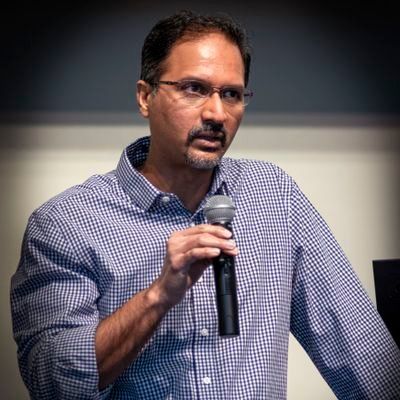- Case-Based Roundtable
- General Dermatology
- Eczema
- Chronic Hand Eczema
- Alopecia
- Aesthetics
- Vitiligo
- COVID-19
- Actinic Keratosis
- Precision Medicine and Biologics
- Rare Disease
- Wound Care
- Rosacea
- Psoriasis
- Psoriatic Arthritis
- Atopic Dermatitis
- Melasma
- NP and PA
- Skin Cancer
- Hidradenitis Suppurativa
- Drug Watch
- Pigmentary Disorders
- Acne
- Pediatric Dermatology
- Practice Management
- Prurigo Nodularis
- Buy-and-Bill
Publication
Article
Dermatology Times
Insight from Anant Madabhushi, PhD on AI in Dermatologic Care
His keynote speech at ACMS focused on artificial intelligence for precision medicine and cancer diagnosis.
“I intentionally labeled my talk after Interpreter of Maladies, which came out about a decade ago chronicling the history of cancer,” said Anant Madabhushi, PhD, FAIMBE, FIEEE, FNAI, and professor at Emory University, at the beginning of his keynote speech. “As we think about artificial intelligence, I do think that AI potentially could be the interpreter of All Maladies.” He has published more than 450 manuscripts, holds more than 100 patents, has secured over $80 million in research grant funding, and is distinguished as a global leader in artificial intelligence (AI) to improve outcomes for patients with cancer. He highlighted the potential of AI to improve the accuracy and efficiency of cancer diagnosis, as well as creating a platform to help make more informed treatment decisions, in his session “Interpreter of Maladies: Applications of AI to Problems in Skin Cancer and Beyond” at the 2023 American College of Mohs Surgery in Seattle, Washington.1
Job Security with AI
One of the most common questions Madabhushi gets is whether AI will replace pathology jobs. The short answer to that is no, it will only help in areas with healthcare disparities. The role of AI and computational imaging would help in diagnostic, prognostic, and predictive tasks to save pathologists and dermatologists time.
He cited a study showing an evaluation of the worldwide pathologist shortage across 134 countries and territories, which is 95% of the global population. Since there is not currently a database to find every pathologist in the world, study results were calculated with resources such as journals, communication with professional societies, and the World Health Organization’s health workforce report. Results showed that there is 1 pathologist for every 125 medical doctors, and 70% of the pathologist workforce is concentrated in 10 countries primarily in the United States, India, China, Brazil, and Russia.2
First Experience With Neural Networks
“I guess we could call it old wine in a new bottle because deep learning is based off of a machine learning algorithm called neural networks since the 60s,” Madabhushi shared. He went on to explain that within the last decade, increasing computational capabilities with better algorithms can be built with capacity for complex tasks. One of the first examples of this approach Madabhushi had in digital pathology was with images of breast cancer, which were annotated for the location of cancer cells and provided to the algorithm. The algorithm was able to learn representations associated with cancer cells and used those representations to identify cancer cells on new images. “The beauty of this approach was that, without actually knowing anything about pathology, one of my students was able to train the algorithms solely based off the location of these cancer cells provided by a pathologist,” he explained.
AI Not Always Smarter
While Madabhushi was working with the University of Pennsylvania 6 years ago, histeam of researchers looked at endomyocardial biopsies to predict the presence of heart failure from MMI target biopsies. They were working with almost 100 images from patients undergoing heart transplants to feed into the algorithm. When measuring efficacy, the algorithm came back with 97% accuracy. For extra validation, the same images were sent to a cardiac pathologistto identify the presence or absence of heart failure, and the AI algorithm was still about 20% more accurate than the pathologist. Needless to say, Madabhushi and his team were estatic and the research made the news.3
The same technology was tested several months later, and the performance fell from 97% accuracy down to 75%. He credits one of his graduate students for realizing a remote software upgrade on the technology had subtly changed the appearance of the images, which disturbed the performance. Madabhushi said, “The takeaway is that we have to be very careful in trusting these brute force algorithms, particularly for problems in medicine and for problems in healthcare. One of the things that our group has been trying to do is figure out ways in which we can intentionally try to address some of these variations in what are called batch effects—the fact that when you get data from one lab and another lab, there are variations in the way these slides are being scammed.”
Concluding Thoughts
Madabhushi shared a variety of recent AI studies he led to research the automated diagnosis of non-melanoma skin cancer4, which was a study published last year. He also gave insight on a preliminary study about squamous cell carcinoma detection from frozen-embedded hematoxylin and eosin-stained slides in Mohs surgery. Both studies gave attendees an idea of how AI technology could help and assist in their day-to-day dermatologic work in the future.
The keynote speaker made it clear that AI is not magic and needs thoughtful and intentional development. Computational analytics with routine imaging and data could help address questions in precision medicine, specifically prognosis and predicting response to therapy. There are major pros to the development of AI including the low cost, time saved, and availability. He did a head-to-head comparison showing that a molecular test costs around $4000, takes 2 weeks to get results back, accessibility in the US only, and the tissue specimen is destroyed. Meanwhile, a pathology test using AI technology costs $4, comes with results in 20 minutes, has the potential for worldwide accessibility, and the tissue specimen is digitized.
References
1. Madabhushi, A. Interpreter of maladies: applications of AI to problems in skin cancer and beyond. Presented at: 2023 American College of Mohs Surgery Meeting; May 4-7, 2023; Seattle, WA.
2. Bychkov A, Fukuoka J. Evaluation of the Global Supply of Pathologists. Modern Pathology. 2022;35:1473-1522. doi:10.1038/s41379-022-01050-6
3. Nirschl JJ, Janowczyk A, Peyster EG, et al. A deep-learning classifier identifies patients with clinical heart failure using whole-slide images of H&E tissue. PLoS One. 2018;13(4):e0192726. Published 2018 Apr 3. doi:10.1371/journal.pone.0192726
4. Zhou Y, Koyuncu C, Lu C, et al. Multi-site cross-organ calibrated deep learning (MuSClD): Automated diagnosis of non-melanoma skin cancer. Med Image Anal. 2023;84:102702. doi:10.1016/j.media.2022.102702








